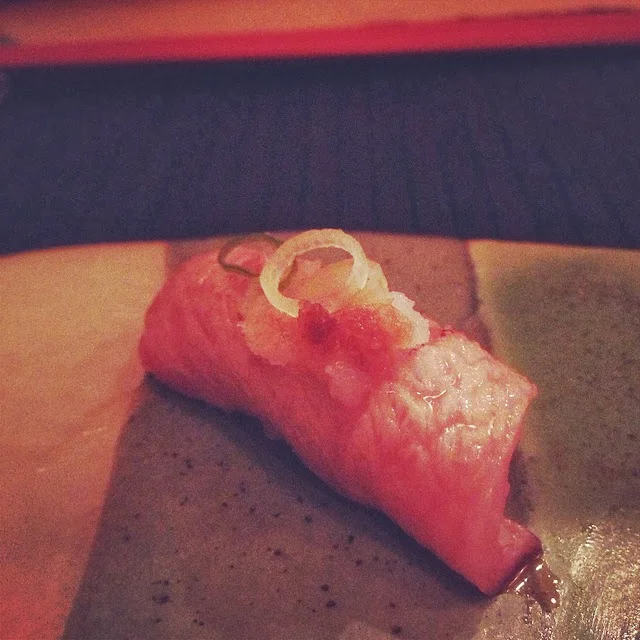Zen in the LES: New York Sushi Ko
Knuckle sandwich: Rice and Fish.
Sushi comes in all forms: the plastic package from a supermarket, rotating past you on a conveyer belt, held atop an hors d’oeuvre tray, and lastly, placed before you with the assured hands of a sushi chef. The best way, we can all agree, is the last one mentioned. But, we can also agree, sushi is pretty good any way you get it.
New York Sushi Ko, a thimble-sized sushi bar on a grubby block in the Lower East Side, is like a Zen garden raked to pebbly perfection. The eleven-seat restaurant is so small that if you glance down for just one second you will blow right past it. At the helm of this blond wood ship is Chef John Daley, a tattooed white guy armed with attitude, sharp knives and a Reggae playing iPod.
An eclectic wine menu. I had a glass of the
, golden-hued and with an amazing depth, for more information see my note at the end.
Since its opening in June, Sushi Ko had been on my list, but I had resisted, mostly because of its price. Thankfully I had a good friend in town with a high-tech budget. There are limited options of what to order, a smattering of a la carte and omakase––chef's choice––at various price levels. The full omakase treatment is $200, which is about what I spent on a few meals in Tokyo last summer, but we opted for a smaller sushi omakase. ($65 for the sushi course and $55 for sashimi.)
Chef John Daley, and his fish.
The opportunity to sit back and chat with a friend and not think about what you're ordering, and not know what is coming next, is one of the finer points of eating a meal like this. Chef Daley, who spoke as if he was running a much larger restaurant, boomed in a deep baritone voice as he placed selections in front of us. The rice grains, slight, loosely packed and lightly flavored, felt distinct. The fish atop it was so fresh that each bite would bring forth a smile and a noise––midway between yum, umm, and yeah––I really couldn't help myself.
The fish choices were unique in where they were from. Many from Japan, some from the eastern coast of the U.S. and a few from out west. Most were served in a straightforward way, unadulterated fish with no soy sauce and no wasabi. A few pieces were sprinkled with lemon, like the live sea scallops, and a sprinkle of salt flakes. An interesting twist on steak tartare came in the form of baby shrimp and shiso leaf, which was really quite ingenious. Somehow Daley had wrapped the tartare around a dollop of rice. A highlight for me was a cut of lean tuna, perhaps Daley said it was from the muscle? This switch from the culturally preferred fatty tuna was nice. It had a firm dense bite, more meatlike than fishlike. Did you know there was once a time when no one wanted tuna on their plates? Before tuna became popular it was deemed too fatty. Bluefin tuna that were caught were tossed back into the sea.
Omakase course
The end of the meal arrived in a blaze of uni, or sea urchin. One piece was from Japan. It tasted completely of the sea, the minerals, and the plankton it swam with. The second was from Santa Barbara. It was creamy and soft, without any of the sea life liquid––just pure clarity of flavor, somewhere between liver and maybe a vegan cheese out of nuts. The Japanese version has a more complete mouthfeel––it doesn't just melt in your mouth. They are both glorious, but I think I have to vote for the uni from Japan. (If anyone is counting my vote.)
Fatty tuna
When I was younger and sitting at a sushi bar, I was too intimidated to talk to the chefs, but sitting in such a small space and eating food that rendered me speechless, I still found my way to chatting with the chef, which is the other fun thing you get to do in such a small space. Daley is personable, funny and chatty. New York Sushi Ko is open well past midnight. Who needs pizza?
Note on the wine: The Scholium Project is a small boutique winery in California. The white I drank, Midan Al-Tahrir, is made from grapes from six vineyards. Founded mostly on skin-fermented Verdelho, a grape common to Portugal, which was grown in Markus Bokisch's red-rocky hillside vineyard in Lodi. Only 526 cases were produced. A quote from their website: "For all its power and richness, the wine is disciplined and refreshing. The wine is neither orange nor cloudy nor a tannic monster. Beautiful if uncommon white wine." I totally agree.





